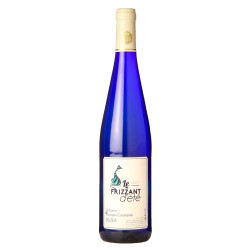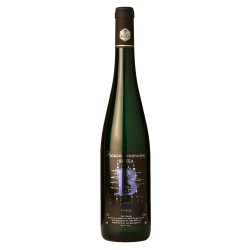The Moselle vineyard extends in the Lorraine region to the northeast of the Paris Basin on the delimited territories of 19 communes in the departments of Moselle and Meurthe-et-Moselle. Eighteen of these communes are located in the department of Moselle and one, the commune of Arnaville is located in the neighboring department of Meurthe-et-Moselle. The vineyard planted at an altitude of less than 250 meters occupies hillsides. The wines of the "Moselle" appellation are produced from eight authorized grape varieties.
Filtrer
Moselle
The Wines of Moselle
The wines of Moselle, produced from a fragmented vineyard along the picturesque Moselle Valley, are a hidden treasure overshadowed by their illustrious Alsatian neighbors. With aromatic white wines, “gray” wines made from Gamay and Pinot Noir, and delicate reds, Moselle wines reflect the diversity and richness of their terroir. Although limited in production, AOC Moselle surprises with the quality and originality of its cuvées, which are worth discovering for wine lovers seeking new taste experiences.
The History of Moselle Wines
Viticulture in Moselle dates back to Roman times, but it truly flourished during the Middle Ages. The bishops of Metz played a crucial role in the development of vineyards, valuing viticulture as a key economic activity. These ancient traditions shaped the wine landscape of Moselle, creating a rich heritage that today’s winemakers strive to uphold with passion and respect for traditional methods.
Over the centuries, Moselle wines have experienced periods of prosperity as well as challenges, notably during wars and political changes that reshaped the region’s borders. Today, the revival of Moselle viticulture is palpable, led by a new generation of winemakers determined to restore this appellation to its former glory. Their efforts have modernized viticulture while preserving the distinctive characteristics of Moselle wines, marked by freshness and unique minerality.
The Climate and Terroir of the Moselle Vineyard
The Moselle vineyard enjoys a continental climate with semi-oceanic influences, characterized by cold winters and warm, moderate summers. This climatic variability is essential for the aromatic development of the grapes grown here, particularly the white varieties that dominate production. The Moselle Valley offers a unique microclimate where south-east to south-west facing slopes optimally capture warmth and sunlight, crucial for grape ripening.
Topographically, Moselle is marked by steep slopes along the river, forming a charming landscape ideally suited for viticulture. The soils are mainly composed of limestone and marl, with areas dominated by slate and schist, adding a characteristic minerality to the wines. These diverse terroirs allow for wines with a complex range of flavors and balanced acidity.
The Different Appellations of Moselle
Though less renowned than other French wine regions, Moselle is home to an Appellation d'Origine Contrôlée: AOC Moselle. This appellation and AOC Côtes de Toul, encompasses a wide variety of wines that perfectly illustrate the diversity and potential of this unique terroir. The wines produced here are predominantly white, made from grapes such as Auxerrois, Pinot Gris, and Müller-Thurgau, which benefit from the mineral expression of the limestone and schist soils. These whites are noted for their freshness, aromatic finesse, and beautiful acidity, often with floral and fruity notes. Other white grape varieties, such as Gewurztraminer, Pinot Blanc, and Riesling, are also permitted under the AOC Moselle appellation.
Although less common, red and rosé (gray) wines are also noteworthy, primarily made from Pinot Noir and Gamay. In terms of production, although the volume remains modest compared to other regions, Moselle focuses on quality and authenticity. Moselle winemakers often adopt sustainable and innovative viticultural practices, aiming to express the unique qualities of their terroir while respecting the environment.
The Iconic Grape Varieties of Moselle
Auxerrois
Auxerrois is a rare white grape variety, highly valued in Lorraine and Moselle for its ability to produce supple and fruity still and sparkling white wines. It offers a rich aromatic palette, with notes of white fruits, citrus, hazelnuts, and white flowers. Auxerrois has a round and soft palate, supported by a fine acidity. This grape is particularly well-suited to Moselle’s cool climate, fully expressing the region’s limestone and mineral terroir.
Pinot Gris
An emblematic grape of Alsace, Pinot Gris takes on a different personality in Moselle, where it stands out for its aromatic intensity and structure. This grape produces wines with colors ranging from pale yellow to golden, exuding aromas of ripe fruits such as apricot, with spicy undertones. On the palate, Moselle’s Pinot Gris reveals a perfect balance of sweetness and complexity, offering a rich texture and a slightly smoky finish.
Müller-Thurgau
Müller-Thurgau is a white grape variety resulting from a cross between Riesling and Madeleine Royale, created in the 19th century by Swiss winemaker Hermann Muller. Although little-known in France, it is widely appreciated in Central Europe and is highly valued in Moselle for its fresh and accessible wines. This grape yields light wines with a clear robe and delicate aromas of flowers and green fruits, such as apple and melon. Its fresh and light palate, with moderate acidity, makes it an excellent aperitif wine.
Pinot Noir
In Moselle, Pinot Noir is cultivated to produce delicate and aromatic red and rosé wines. The red wines from this grape variety often present notes of cherry and raspberry, with a light tannic structure and balanced acidity. The rosé or gray wines, on the other hand, are enticing with their freshness and aromas of fresh red fruits.
Alongside these emblematic grapes, other varieties like Gamay (for red and rosé wines), Riesling, Gewurztraminer, and Pinot Blanc also feature in Moselle.
Moselle Wines: The Best Food and Wine Pairings
Moselle Wines with a Starter
For an aperitif or with a tarte flambée, opt for a gray wine from an AOC Moselle domaine made from Gamay. This subtle and indulgent Moselle rosé wine combines freshness and lightness, making it an excellent choice to enjoy on its own as an aperitif. If you prefer white wine, a blend of various local grape varieties, soft and fruity under AOC Moselle, is a great alternative to complement light dishes like quiche lorraine or onion tart.
Moselle Wines with a Main Course
For a regional food and wine pairing with a pork pie or sauerkraut, choose a red wine from an AOC Moselle domaine made from Pinot Noir. With its notes of red fruits (cherry, strawberry, raspberry), peony, and round mouthfeel, Moselle red wine is perfectly suited for dishes made with white meat or charcuterie.
Moselle Wines with a Dessert
To enjoy with a mirabelle plum tart from Nancy, nothing beats a bottle of white wine from an AOC Moselle domaine with notes of yellow fruits, apricot, citrus, and nutmeg. If you prefer cheese at the end of the meal, try a white wine based on Müller-Thurgau or Auxerrois to enhance a Munster or Cancoillotte. Moselle’s white wines bring a touch of freshness and minerality that pairs wonderfully with cheese.
With its wide variety of wines and unique grape varieties, Moselle’s vineyard has many assets to delight wine enthusiasts looking for something new. On Avenue des vins, each cuvée is selected with the utmost care, and all our wines are available for delivery to your home, directly from the domaine or château of your choice. Embark on a discovery of Moselle wines or explore those from other French regions, enjoying our bottles at the best quality-price ratio, delivered straight to you!


